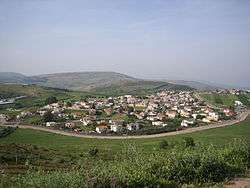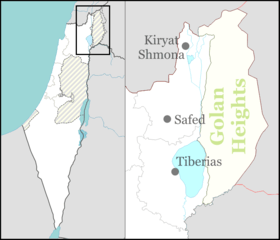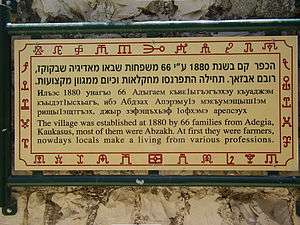Rehaniya
Rehaniya (Hebrew: רִיחָנִיָּה, Arabic: الريحانية, Adyghe: Рихьаные [rəjħaːnəja]) is a predominantly Circassian village in northern Israel. Located about 8 km north of Safed, it falls under the jurisdiction of Merom HaGalil Regional Council. In 2018, it had a population of 1,184.[1]
Rehaniya רִיחָאנִיָּה الريحانية | |
|---|---|
 | |
 Rehaniya | |
| Coordinates: 33°2′54.12″N 35°29′15.36″E | |
| Country | Israel |
| District | Northern |
| Council | Merom HaGalil |
| Founded | 1878 |
| Population (2018)[1] | 1,184 |
| Name meaning | Myrtle |
History

The Circassians arrived in the Middle East after they were pushed out of their homeland in the North Caucasus. The Circassians, who fought during the long period wherein the Russians captured the northern Caucasus, were massacred and expelled by Tsarist Russia from the Caucasus in an incident that became known as the Circassian Holocaust. The Ottoman Empire absorbed them in their territory, and settled them in sparsely populated areas, including the Galilee in Beirut Vilayet (Ottoman Syria).
The area where they settled was called Burak Alma ("Pools of Alma").[2]
The village of Rehaniya was established in 1873, but only in 1878 did Circassian families arrive from the Abazah tribe in the northern Caucasus, a region where today is located the Adygea and Karachay–Cherkessia in the Russian Federation. The village itself was established in 1880 by 66 families, most of whom were Abzakhs.
British Mandate era
In the 1922 census of Palestine conducted by the British Mandate authorities, Rihania had a population of 211; all Muslims,[3] increasing slightly in the 1931 census to 222, still all Muslims, in a total of 53 houses.[4]
In the 1945 census by the Mandate, the population was 290 people (all Muslims)[5][6] and the land area was 6,137 dunums.[7] 271 dunums of land were irrigated or used for orchards; 4,725 dunums were allocated to cereal farming,[8] while 89 dunams were built up (urban) land.[9]
1948, aftermath
The village was built in the traditional Circassian style, which has its roots in the Caucasus, and is called "walled village": the houses are built next to one another and form a protective wall around the city, whose remnants remain until 2008. In the village there is a mosque in the style of Circassian mosques in the Caucasus, and substantially different from Arab mosques. Also, the village contains a museum and a center for Circassian heritage.[10]
In 1948, during Operation Hiram (29–31 October), the villagers surrendered to the advancing Israeli army and were allowed to remain in the village. In November 1949, a plan to evict the villagers, as well as those from five other villages along the border with Lebanon, was presented to the Israeli cabinet. The proposals were strongly supported by the IDF, but the plan was vetoed by the Foreign Ministry who were worried about the possible international response.[11] The village remained under Martial Law until 1966.
Rehaniya is one of two predominantly-Circassian villages in Israel. The other one is Kfar Kama. The Circassians are Muslims, who unlike the main Israeli Arab Muslim minority, perform military service in the Israeli Defense Forces.[10][12] Rehaniya reached local council status in 1950.
See also
References
- "Population in the Localities 2018" (XLS). Israel Central Bureau of Statistics. 25 August 2019. Retrieved 26 August 2019.
- Palmer, 1881, p. 70
- Barron, 1923, Table XI, Sub-district of Safad, p. 41
- Mills, 1932, p. 109
- Government of Palestine, Department of Statistics, 1945, p. 10
- United Nations Conciliation Commission for Palestine, Village Statistics, April 1945, p. 5 Archived 2012-06-09 at the Wayback Machine
- Government of Palestine, Department of Statistics. Village Statistics, April, 1945. Quoted in Hadawi, 1970, p. 71
- Government of Palestine, Department of Statistics. Village Statistics, April, 1945. Quoted in Hadawi, 1970, p. 120
- Government of Palestine, Department of Statistics. Village Statistics, April, 1945. Quoted in Hadawi, 1970, p. 170
- Gilad, Moshe (2012-07-05). "A Slightly Rarefied Circassian Day Trip". Haaretz.
- Morris, Benny (1987). The Birth of the Palestinian refugee problem, 1947-1949. Cambridge University Press. pp. 226, 242, 251. ISBN 0-521-33028-9.
- Muslim revivalism and the emergence of civic society. A case study of an Israeli-Circassian community
Bibliography
- Barron, J.B., ed. (1923). Palestine: Report and General Abstracts of the Census of 1922. Government of Palestine.
- Government of Palestine, Department of Statistics (1945). Village Statistics, April, 1945.
- Hadawi, S. (1970). "Village Statistics of 1945: A Classification of Land and Area ownership in Palestine". Palestine Liberation Organization Research Center. Cite journal requires
|journal=(help) - Mills, E., ed. (1932). Census of Palestine 1931. Population of Villages, Towns and Administrative Areas. Jerusalem: Government of Palestine.
- Morris, B. (1987). The Birth of the Palestinian refugee problem, 1947-1949. Cambridge University Press. ISBN 0-521-33028-9.
- Palmer, E.H. (1881). The Survey of Western Palestine: Arabic and English Name Lists Collected During the Survey by Lieutenants Conder and Kitchener, R. E. Transliterated and Explained by E.H. Palmer. Committee of the Palestine Exploration Fund.
External links
- SWP map IV, IAA
- SWP map 4, Wikimedia commons
- The Circassians in Israel
